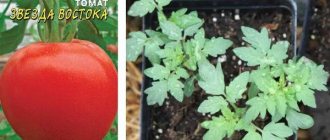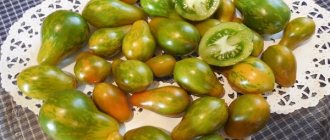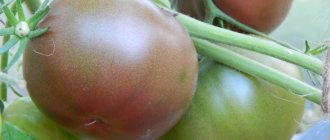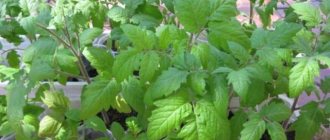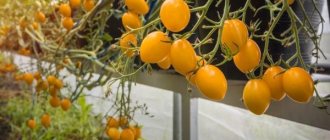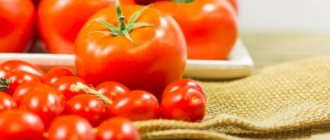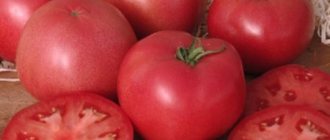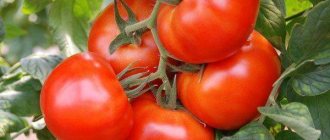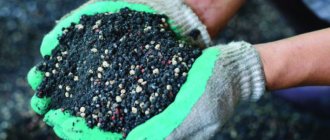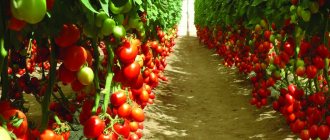Characteristics of the variety
Salad tomatoes are valued for their taste. Tender pulp and high sugar content give tomatoes an unusual, fruity taste. If we add to this the exotic, honey color of the fruit, then we can say with confidence that such a “gold” vegetable will become a worthy decoration for any table. The Gold of the East is precisely the kind of tomato that attracts attention with its appearance and taste, somewhat reminiscent of the famous oriental sweets. This is what the description of the variety looks like.
The variety is mid-season, with a growing season of 115 days, which allows it to be grown in central Russia, with a fairly short period of above-zero temperatures.
- The variety is recommended for cultivation in various types of greenhouses. In areas with a warm climate, it can be safely cultivated in open ground without shelter.
- The plant is tall, reaching a height of 2 meters during the growing season. The indeterminate type of bush requires timely pinching of the growing point and regular removal of side shoots.
- In one cluster, from 4 to 6 fruits are formed, the weight of which on average ranges from 120 g to 200 g, especially large ones reach a weight of 400 g.
- The fruits are oval elongated, yellow with an orange tint. The pulp is juicy and dense. The taste is rated as excellent. The purpose of tomatoes is salad, despite this they are well ripened and stored.
Gold of the East is a variety that has earned only positive reviews for its excellent consumer qualities. The excellent taste allows the fruits to be used for preparing fresh salads, snacks, and all kinds of exotic dishes.
Important! Unripe tomatoes are removed from the stalk and ripened at room temperature. After 6–8 days, the fruits acquire the taste and aroma characteristic of the variety.
Description of the tomato variety Golden Nugget and its characteristics
The “Golden Nugget” tomato is a mid-early variety that produces good yields in the ground.
Let’s begin the description of “Golden Nugget” tomatoes with the fact that the period from the germination of the seeds of this variety to the harvest is about 110-115 days. The bush of the plant is medium, grows above 1-1.2 meters. The leaves are light green, slightly elongated. The trunk is flexible, it is best to form it into 2 stems. It is advisable to tie up and remove the stepsons, since this variety grows very strongly. In open ground, you can grow these tomatoes on a trellis.
Characteristics of the bush: up to 10 brushes can form on one bush of the plant. These tomatoes grow in clusters, each cluster contains 6-8 pieces, and sometimes more. The weight of the fruit is 50-120 g, and the length is 5-7 cm.
Seeds of the “Golden Nugget” variety do not lose their properties in the second and subsequent generations. Tomatoes produce the best harvests within a year.
Characteristics of the fetus
The shape of the fruits of the “Golden Nugget” variety is cylindrical, creamy. Ripe tomatoes are honey-yellow in color; only ripe tomatoes have a pale yellow color with a greenish tint. The pulp of amber “cream” is juicy, tasty, aromatic, the seeds are small. These tomatoes are great for whole-fruit canning and fresh consumption. Golden “cream” in jars looks great, especially beautiful when combined with gherkins or slices of other tomatoes. Reviews about the “Golden Nugget” are only positive.
Transportation over long distances is possible without losing the presentation of the fruit. Tomatoes “Golden Nugget” are shelf-stable, ripen well and retain their taste.
Disease resistance and processing
An important characteristic of the “Golden Nugget” variety is resistance to disease. It does not suffer from tomato tobacco mosaic virus, is resistant to tomato bronzing, Alternaria, gray spot, Fusarium wilt, yellow leaf curl virus, and is resistant to spotted and verticillium wilt virus. However, during periods of epidemics, treatment of bushes is necessary for prevention.
Tomatoes become more resistant to fungal infections if mineral fertilizers containing potassium, magnesium, and nitrogen salts are used.
Advice and agricultural technology
Before sowing, seeds must be disinfected in a pink solution of potassium permanganate for 20 minutes. For germination, seed material can be soaked in warm water for 12-20 hours. Also soak the seeds in aloe juice for the same time.
Winter crops should always be illuminated with a phytolamp or fluorescent lamps. The seeds are sown in light, fertile soil. It is good to add ash to the soil mixture of soil, humus and sand, about 0.5 liters per bucket of soil.
To get a high-quality harvest, at all stages it is necessary to observe the temperature regime for seedlings and tomato bushes.
Features of cultivation
In matters of caring for the variety, the manufacturer does not put forward any unusual requirements:
- It is recommended to sow seeds for seedlings in mid-March. Tomato seedlings are transplanted into the greenhouse in the second half of May.
- Planting pattern 40x70 cm, with a frequency of 4 plants per square meter. meter of area. Plants must be tied to a reliable support or trellis.
- The bush is formed into 1–2 trunks, depending on climatic conditions. When 4–6 brushes are formed, the growth point is pinched. Side shoots are removed weekly, preventing the shoots from overgrowing.
- Tomato care is traditional, including watering, weeding and scheduled fertilizing.
Tomato “Golden”: variety description, photos and reviews
Do you know that:
It is believed that some vegetables and fruits (cucumbers, stem celery, all varieties of cabbage, peppers, apples) have “negative calorie content,” that is, more calories are consumed during digestion than they contain. In fact, only 10-20% of the calories received from food are consumed in the digestive process.
Both humus and compost are rightfully the basis of organic farming. Their presence in the soil significantly increases the yield and improves the taste of vegetables and fruits. They are very similar in properties and appearance, but they should not be confused. Humus is rotted manure or bird droppings. Compost is rotted organic remains of various origins (spoiled food from the kitchen, tops, weeds, thin twigs). Humus is considered a higher quality fertilizer; compost is more accessible.
In Australia, scientists have begun experiments in cloning several varieties of grapes grown in cold regions. Climate warming, which is predicted for the next 50 years, will lead to their disappearance. Australian varieties have excellent characteristics for winemaking and are not susceptible to diseases common in Europe and America.
Natural toxins are found in many plants; Those grown in gardens and vegetable gardens are no exception. Thus, the seeds of apples, apricots, and peaches contain hydrocyanic acid, and the tops and peels of unripe nightshades (potatoes, eggplants, tomatoes) contain solanine. But do not be afraid: their number is too small.
“Frost-resistant” varieties of garden strawberries (more often simply “strawberries”) need shelter just as much as ordinary varieties (especially in those regions where there are snowless winters or frosts alternating with thaws). All strawberries have superficial roots. This means that without shelter they freeze to death. Sellers’ assurances that strawberries are “frost-resistant,” “winter-hardy,” “tolerates frosts down to −35 ℃,” etc. are deception. Gardeners must remember that no one has yet managed to change the root system of strawberries.
In little Denmark, any piece of land is a very expensive pleasure. Therefore, local gardeners have adapted to growing fresh vegetables in buckets, large bags, and foam boxes filled with a special earthen mixture. Such agrotechnical methods make it possible to obtain a harvest even at home.
Humus is rotted manure or bird droppings. It is prepared like this: the manure is piled up in a heap or pile, layered with sawdust, peat and garden soil. The pile is covered with film to stabilize temperature and humidity (this is necessary to increase the activity of microorganisms). The fertilizer “ripens” within 2-5 years, depending on external conditions and the composition of the feedstock. The output is a loose, homogeneous mass with a pleasant smell of fresh earth.
Convenient Android applications have been developed to help gardeners and gardeners. First of all, these are sowing (lunar, flower, etc.) calendars, thematic magazines, and collections of useful tips. With their help, you can choose a day favorable for planting each type of plant, determine the timing of their ripening and harvest on time.
The homeland of pepper is America, but the main breeding work on developing sweet varieties was carried out, in particular, by Ferenc Horvath (Hungary) in the 20s. XX century in Europe, mainly in the Balkans. Pepper came to Russia from Bulgaria, which is why it received its usual name - “Bulgarian”.
Advantages of the variety
The Zoloto Vostok tomato is intended for cultivation in open ground and greenhouses. During the growing season, a bush with a height of 150-200 cm is formed. A tomato with an average ripening period, fruiting occurs in 115-117 days.
The description of the vitamin and mineral composition of the fruit allows them to be included in the diet. They contain fiber, organic acids, magnesium, iron, iodine, folic and nicotinic acids.
When growing, the crop requires compliance with the light regime. In the ripe phase, tomatoes acquire an intense yellow color. Tomatoes have an oval, slightly elongated shape, a smooth surface, juicy pulp, and rich taste.
- 5-6 fruits ripen in a cluster, the weight of which reaches 120-200 g, in some cases - 400 g.
- With a horizontal cut, 4-6 chambers with seeds are observed.
- Tomatoes are used fresh for preparing various dishes.
Fruit characteristics
The fruits of the Eastern Star hybrid are dense and smooth, have a round shape and weigh from 200 to 300 g. The color is rich crimson-pink. Tomatoes grow in clusters of 5-6 pieces. Suitable for fresh consumption and processing into tomato products.
Tomato Vostok f1 universal purpose. Its fruits are well used fresh, processed and stored for the winter.
Detailed characteristics of tomatoes:
- weight - 200-300 grams;
- shape - flat-round;
- the skin is thick, ribbed;
- color - bright red;
- pulp - fleshy, loose;
- seed content - large quantity;
- taste - spicy, sweetish.
Vostok tomatoes are highly resistant to high humidity and drought. They have a good long shelf life and ripen well after being picked from the bush at home.
Agrotechnics of cultivation
To sow tomatoes, use a special container with a drainage hole at the bottom to protect the plants from blackleg disease. A soil mixture of sand and peat or a universal substrate is poured into the containers.
Before planting in the soil, the seeds are treated with an aqueous solution of potassium permanganate (aloe) and a growth stimulator. The seed is planted to a depth of 1 cm and watered with warm water using a sprayer. To form strong seedlings, seeds are planted at a distance from each other.
The container is covered with film and placed in a well-lit place with regular air circulation. Until the first shoots appear, the temperature is maintained at +23 °C. After the first shoots appear, the film is removed so as not to expose the plants to excess moisture evaporation.
Periodically moderate watering is carried out with a finely sprayed stream so as not to flood the seedlings with water. In the phase of formation of 1-2 true leaves, seedlings are picked into separate pots.
For this purpose, peat containers are used, with which it is convenient to transplant the bushes to a permanent place. To better adapt seedlings to new conditions, seedlings can be hardened from the moment the first shoots appear.
Among the tomato varieties popular among domestic summer residents, the leading position has long been occupied by a hybrid that received the poetic name “Gold of the East.” This crop is characterized by high yield and resistance to common diseases. Due to their rich taste, tomatoes are widely used for canning and preparing vegetable dishes. We will tell you in detail about the features of this hybrid, as well as the rules for growing it.
How to grow tomatoes correctly Gold Medal
The history of growing any tomato begins with collecting and processing seeds; we will skip this point and start with preparing seedlings. The sowing time for the Gold Medal tomato should be determined independently; calculations are easy to do if you consider that plants can be planted in open ground 65 days after germination, and in a greenhouse after 55 days. The seeds will hatch 5 or 10 days after sowing; you can speed up the process by soaking the grains.
Growing seedlings
Let's move on to the most important process, which needs to be treated with special care. Here you cannot miss a single detail and neglect the main rules:
- you can buy a ready-made mixture for seedlings or prepare it yourself - mix equal parts of disinfected garden soil, river sand or vermiculite and compost, add a little mineral fertilizer diluted in water (20 g of potassium, 10 g of urea and 30 g of superphosphate per 10 liters of water) . You cannot take soil from the garden;
- the container for seedlings is thoroughly washed and disinfected with a solution of potassium permanganate;
- Fill the prepared pots or boxes with a slightly moistened mixture, leaving 2 cm sides. Shallow grooves (1 cm) should be made in the soil at a distance of 3, 5 or 4 cm and the seeds should be placed in them. Now the grains can be sprinkled with soil and sprayed with a spray bottle;
- Before emergence, seedlings are covered with glass and placed in a warm (at least 22 ° C), well-lit room;
- When the seeds hatch, the cover must be removed and the seedlings must be watered with warm, settled water, carefully, without eroding the soil at the roots. The second watering is carried out after 2 weeks, but in general, it is better to monitor the soil and not allow it to dry out even slightly. After another 14 days, you can feed the seedlings, for example, with Effect liquid fertilizer (according to the instructions);
- It is advisable to place the seedlings on the south side, where there is more light and heat; if this is not possible, you will have to take care of additional lighting;
- picking is carried out in the phase of 2 or 3 true leaves; elongated bores can be buried in the ground up to the cotyledon leaves. Now the seedlings need to be watered once every 7 days until the soil is completely wet; if the soil dries out faster, the procedure is carried out more often;
- A few weeks before planting the seedlings, you need to start ventilating the room and opening the window. At first, for a short time and gradually increase the time, and a day before planting, the bushes are taken outside into the shade.
A week before planting tomatoes in a permanent place, watering is reduced, and on the day of planting, water generously. If, before the scheduled day, the seedlings managed to acquire a flower brush, it is advisable to spray the bushes with boric acid (tsp per 1 liter of water).
How to care for a tomato Gold Medal
Even the most unpretentious tomato variety requires basic knowledge regarding cultivation. Tomato bush Gold Medal, due to the large weight of the fruit, it is formed into 1 or 2 stems. When planting, pegs or trellises are immediately installed for garter; during the growing season, weeds are removed, the beds are mulched, and stepsons and excess foliage are removed. There are no special recommendations for watering and fertilizing.
Tomato Gold Medal fully lives up to its name; it was given to it deservedly. Not every variety can boast so many positive qualities; there are disadvantages, but they are insignificant. It is not surprising that this tomato has so many fans.
Characteristics of the variety
The tomato “Gold of the East” received its unusual name for its color, similar to the color of the noble metal. This variety is included in the “Oriental Delicacy” collection because it has an exotic taste. The plant has adapted well to the difficult climatic conditions of our country and is successfully cultivated in the middle zone. Moreover, it feels great both in greenhouse conditions and in open ground. The variety belongs to mid-season tomatoes. Its growing season is about 115 days, which allows for a decent harvest in regions where there is a short period of above-zero temperatures.
If we talk about the main characteristics of this variety, you should pay attention to the following qualities:
- The Zoloto Vostok tomato can be grown in open soils without shelter in places with a warm climate.
- A mature plant reaches two meters in height and forms the so-called indeterminate type of bush. Therefore, agrotechnical measures include the mandatory removal of side shoots and timely pinching of growth points. Moreover, such procedures should be carried out regularly.
- By the time of ripening, tomato bushes form clusters containing up to 6 massive honey-colored fruits. The weight of other specimens reaches 0.4 kg.
- The hybrid Gold of the East is famous for its amazing sweetish taste and juicy pulp.
- This variety can withstand relatively long storage periods, although it is mainly used for preparing salads and canning.
Helpful information!
It is recommended to remove the tomatoes from the “gold” series together with the stalk, and then they ripen at room temperature for about a week. During this time, the fruits have time to acquire the characteristic taste of this variety.
Advantages of a hybrid
When creating the variety, breeders tried to combine the best qualities of famous tomatoes in their brainchild. Therefore, the hybrid “Gold of the East” has a number of advantages:
- It can be safely cultivated in various conditions: greenhouses, open ground.
- The short growing season allows the fruits to ripen completely.
- Consistently high yields make this variety the most promising for growing in summer cottages.
- A set of nutritional components, including organic acids and a whole complex of vitamins, allows the use of tomatoes of this variety for dietary nutrition.
Of course, the main advantage of the Zoloto Vostok tomato is its exotic taste. It is this quality that is most valued by gardeners and gourmets. After all, from this representative of the nightshade family you can prepare a lot of delicacies and snacks using minimal heat treatment.
Advantages and disadvantages
Pros:
- productivity;
- large fruit;
- commercial qualities.
Minuses:
- the need for stepsoning.
There are many reviews from gardeners about this hybrid, which allows us to highlight its main advantages. These include:
- High and stable yield;
- Immunity to diseases;
- Good taste characteristics;
- Resistance to stressful conditions.
When creating the variety, breeders tried to combine the best qualities of famous tomatoes in their brainchild. Therefore, the hybrid “Gold of the East” has a number of advantages:
- It can be safely cultivated in various conditions: greenhouses, open ground.
- The short growing season allows the fruits to ripen completely.
- Consistently high yields make this variety the most promising for growing in summer cottages.
- A set of nutritional components, including organic acids and a whole complex of vitamins, allows the use of tomatoes of this variety for dietary nutrition.
Of course, the main advantage of the Zoloto Vostok tomato is its exotic taste. It is this quality that is most valued by gardeners and gourmets. After all, from this representative of the nightshade family you can prepare a lot of delicacies and snacks using minimal heat treatment.
Golden Canary tomato - description and characteristics of the variety
The Zoloto Vostok tomato is characterized by high productivity and resistance to diseases of nightshade crops. Tender, juicy orange fruits are rich in vitamins and beneficial components, used fresh and for canning.
To sow tomatoes, use a special container with a drainage hole at the bottom to protect the plants from blackleg disease. A soil mixture of sand and peat or a universal substrate is poured into the containers.
Before planting in the soil, the seeds are treated with an aqueous solution of potassium permanganate (aloe) and a growth stimulator. The seed is planted to a depth of 1 cm and watered with warm water using a sprayer. To form strong seedlings, seeds are planted at a distance from each other.
The container is covered with film and placed in a well-lit place with regular air circulation. Until the first shoots appear, the temperature is maintained at 23 °C. After the first shoots appear, the film is removed so as not to expose the plants to excess moisture evaporation.
Periodically moderate watering is carried out with a finely sprayed stream so as not to flood the seedlings with water. In the phase of formation of 1-2 true leaves, seedlings are picked into separate pots.
For this purpose, peat containers are used, with which it is convenient to transplant the bushes to a permanent place. To better adapt seedlings to new conditions, seedlings can be hardened from the moment the first shoots appear.
In this case, the temperature is reduced to 8... 10 °C at night and 15 °C during the day for 3 days. Hardening is carried out until transplantation into the greenhouse. For growing tomatoes, areas located in the southern part are chosen.
Preparing the soil for seedlings requires mandatory loosening and enrichment with potassium and nitrogen fertilizers. Before planting, make holes and water them well.
The best predecessors for tomatoes are cucumbers, zucchini, onions, and carrots. It is recommended to place 2-3 bushes per 1 m². It is necessary to plant seedlings a little deeper than they grew in the greenhouse.
Caring for plants involves timely watering, application of complex fertilizers, and loosening the soil. To prevent fungal diseases, use the fungicide Ridomil Gold MC. It provides partial protection against diseases that appear along with tomato late blight.
Reviews from gardeners cultivating the Zoloto Vostok variety indicate excellent taste characteristics of the tomato and abundant fruiting over a long period.
“I grow the Gold of the East tomato in a greenhouse. Tall bushes are characterized by high productivity; ripe fruits can be harvested from them within 1.5 months. The tomatoes are juicy, have a delicate aroma, and most importantly, do not cause allergies when consumed fresh.”
“I plant the Golden of the East tomato in open ground. During the entire growing season, I remove excess shoots from the bushes and make sure to tie them to a trellis so that the stems do not deform under the weight. The fruits have an intense tomato flavor, are sweet, and are excellent for canning. I use larger tomatoes, weighing up to 350 g, fresh for making salads.”
Rules of agricultural technology
Before sowing seeds, which is usually done in mid-March, care must be taken to prepare appropriate containers for these purposes. Experts recommend using special containers with a drainage hole, which will prevent the development of seedling diseases. Containers for seedlings are filled with a mixture of peat and sand, and before sowing, the prepared soil should be treated with a solution of potassium permanganate. The seeds are sown to a depth of 1 cm, and the planting site is sprinkled with warm water. You can use a regular sprayer for this.
Agricultural technology instructions
Before sowing seeds, which is usually done in the middle of Marfa, care must be taken to prepare containers appropriate for these purposes. Experts recommend using special containers with a drainage hole, which will prevent seedlings from becoming sick. Containers for seedlings are filled with a mixture of peat and sand, and before sowing, the prepared soil should be treated with a solution of potassium permanganate. Superelite is laid to a depth of 1 cm, and the planting site is sprayed with warm water. You can use a regular sprayer for this.
To provide favorable conditions for the sprouts, sowing should be done at a distance of 4 cm. After sowing, the container should be covered with film and placed in a lighted place where there is good circulation of air masses. Until the first shoots appear, it is necessary to maintain the temperature at +23 C. When the sprouts “hatch”, it is not forbidden to remove the film.
Care instructions
Zoloto Vostok tomatoes do not require special care at the stage of growing seedlings. The required set of measures includes the following procedures:
- Regular watering.
- After the formation of 2 true leaves, you need to dive the seedlings.
- In the second half of May, the strengthened sprouts are planted in a greenhouse. They should be planted in open soils after frosts have stopped.
- Planting frequency – 4 plants per square meter of sown area.
- Tomatoes need to be tied to a reliable support.
- When the bushes are formed, you need to pinch them. Side shoots should be removed regularly.
- The feeding and watering periods for this variety are exactly the same as for other tomatoes.
Important point!
The hybrid Zoloto Vostok can be grown in one place for several years in a row if the soil is enriched with organic fertilizers.
Gold of the East is one of the few crops that have gained special favor among summer residents and farmers. Easy-to-care tomatoes produce amazing yields. Therefore, the reviews from gardening enthusiasts are the most positive.
Reviews
- Marina Nikolaevna, Bryansk:
By chance I came across several seeds of this amazing hybrid. I sowed it just for fun. But, as expected, the seedlings sprouted in unison. I planted it in a greenhouse, and by autumn I harvested an unprecedented harvest from several bushes. There were so many tomatoes that they had to be distributed to neighbors. Indeed, a golden variety! Now I’m allocating the best place for these tomatoes on the plot. - Alexey Pavlovich, Krasnodar:
I am always interested in new varieties of tomatoes, since I am a farmer. I ordered seeds of the “Gold of the East” variety two years ago on the Internet. I must say, the order was completed quickly. In the first season I planted tomatoes in a greenhouse and in the ground. The result was almost the same in both cases: the fruits are large and juicy. He sold part of the harvest at the market, and kept part for personal needs. I especially liked the unusual taste of this variety.


